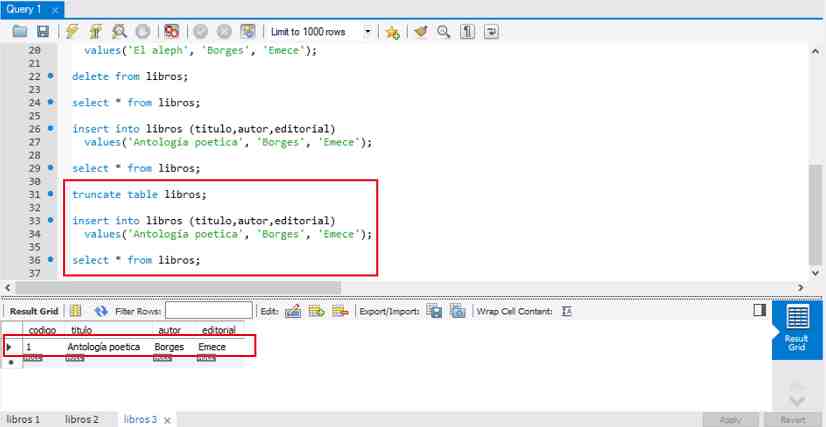

I do not have a good explanation as for why the RENAME TABLE succeeds to respond faster than TRUNCATE. MySQLs TRUNCATE statement drops a table and all its records and then recreates it as an empty table. If you care about not using same AUTO_INCREMENT values, you can: ALTER TABLE log_table_new AUTO_INCREMENT= some high enough value Do note that AUTO_INCREMENT values can be tricky here: the “new” table is created with an AUTO_INCREMENT value which is immediately taken in the “working” table. RENAME TABLE log_table TO log_table_old, log_table_new TO log_table Instead of: TRUNCATE log_tableĭo: CREATE TABLE log_table_new LIKE log_table What’s faster than TRUNCATE, then? If you don’t have triggers nor FOREIGN KEYs, a RENAME TABLE can come to the rescue. TRUNCATE on tables with no FOREIGN KEYs should act fast: it translate to dropping the table and creating a new one (and it all depends on the MySQL version, see the manual). The TRUNCATE hanged nothing else would work minutes pass. But sometimes it just hangs I’ve has several such uncheerful events with InnoDB (Plugin) tables which were extensively written to. It does not activate the triggers applied on the table.TRUNCATE is usually a fast operation (much faster than DELETE FROM). It activates the triggers on the table and causes them to fire The TRUNCATE statement does not delete the table structure but resets the identity of the table The DELETE statement deletes the records and does not interfere with the table's identity. You cannot restore the deleted data after executing this command. You can restore the data using the COMMIT or ROLLBACK command. It records only the deleted data pages in the transaction log. It records all the deleted data rows in the transaction log. Its speed is fast as it only records data pages in transaction logs. Its speed is slow as it makes operations in rows and records it in transaction logs

TRUNCATE operates on data pages and executes deletion of the whole table data at a time. Also running: mysql -e 'SHOW ENGINE INNODB STATUS\G'. Then kill the queries which are using it (change 123 to Id of the process): mysqladmin kill 123. The TRUNCATE command requires fewer locks and resources before deleting the data page because it acquires the lock on the data pageĭELETE operation operates on data records and executes deletion one-by-one on records in the order of the queries processed The TRUNCATE may hang, because other processes could use this table, so to check run in shell: mysqladmin proc. The DELETE command acquires the lock on every deleting record thus, it requires more locks and resources. The TRUNCATE command is used to delete the complete data from the table. The DELETE command is used to delete particular records from a table. The following table will help you understand the key difference between DELETE and TRUNCATE Commands. The Key Difference Between Delete and Truncate Now you will run the following SQL query to check the table structure.Īs you can see above, though the players’ table has been truncated, the table structure remains intact. This SQL query will remove all the records from the table. Here you will use the truncate command to delete all records from the table players. Let’s understand this with the help of an example. The syntax for the TRUNCATE command to remove data from the table: Execution of this command locks the pages instead of rows therefore, it requires fewer locks and resources. You cannot roll back the deleted data as it does not register the log during the execution of this operation. You cannot use the WHERE clause with this command therefore, you cannot filter the records. The Truncate statement is a DDL or Data Definition Language command that is used to delete the complete data from the table without deleting the table structure. with player_id = 106, from the players' table. The SQL query mentioned above will remove the last row, i.e. Now you must write a query to delete the last record with player_id = 106.ĭelete from players where player_id = 106 Insert into players (player_id, name, country, goals) You will create a table named players and insert a few records on the table.Ĭreate table players (player_id int, name varchar(20), Now, understand this with the help of an example. Therefore, you should have a database backup before executing this command.īelow is the syntax for the DELETE command to remove data from the table: After executing this command, you cannot recover the deleted records.


 0 kommentar(er)
0 kommentar(er)
